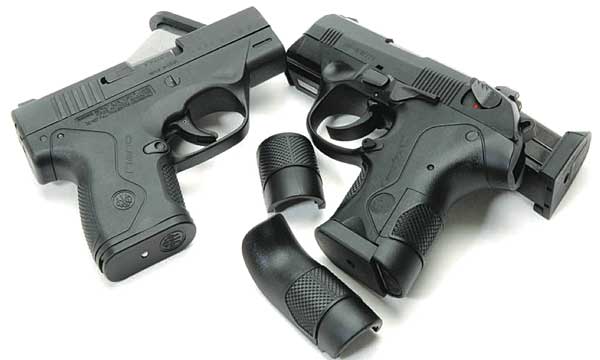
Beretta now has two polymer and steel subcompact pistols – the Px4C Storm Subcompact and the Nano. The Px4C is the subcompact version of the Px Storm (now the Px4), introduced in 2005, which was followed by a compact and, now, this subcompact version. Both the Px4C and the Nano are offered in 9x19mm or .40S&W chambering. The samples discussed here are in 9x19mm. The Nano is the new kid on the block. Both are purpose-built to address the needs and wants of particular handgun audiences. The larger Px4C holds 13 rounds, while the Nano holds six rounds.
The smaller Nano has only one external control – a magazine release. If you count the trigger drop safety, the total rises to all of two. The Nano also comes in with a lower MSRP of $475, compared to the $550 MSRP of the Px4C Storm.
Beretta Model Px4C Storm Subcompact Handgun
The Px4C follows on the Px4 Storm, as noted above, which was a first for Beretta, as the Storm was the company’s first polymer framed, centerfire handgun. At the time, I reviewed the pistol for P&SN and, looking back and comparing the new Px4C Storm to the original, there have been some changes made.
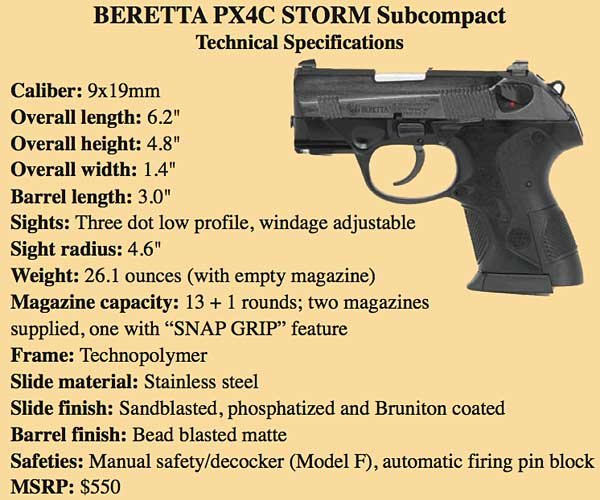
Reviewing what I wrote at the time, I noted how the Storm had a number of options: choice of backstrap, slide stop, sights and magazine catch button, as well as calibers – 9x19mm and .40S&W – which are continued with the Px4C Storm.
With the trigger system used in this sample, the ambidextrous manual safety/hammer decocker must be manually moved to decock the rounded and serrated external hammer (which has a half cock notch) and must be moved to its original position to fire. Three changeable backstraps – small, medium and large – are included.
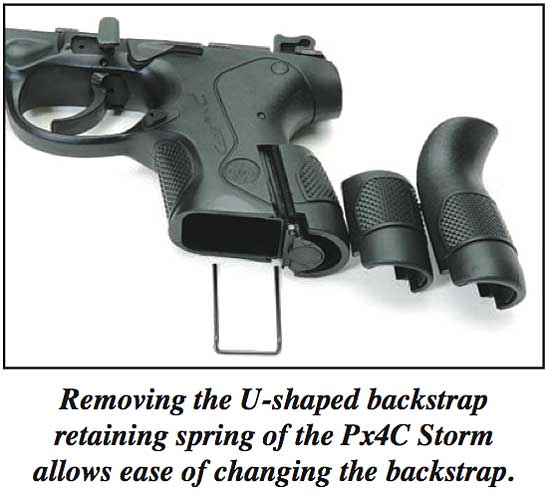
Features
As delivered, the Px4C Storm has two magazines with removable polymer base plates. One of these has a Beretta patented, “extendable” SNAP GRIP base plate which, when the gun is gripped, allows the little finger of one’s grasping hand to press downward enough so that the forward lip of the SNAP GRIP base plate unsnaps and the now downward hinged part becomes a lower and deeper finger rest, to give a large hand a better grip on the pistol.
Optional accessories include a lanyard loop, four additional rear sight heights, two additional sizes of magazine release buttons and an extended slide stop.
The supplied square notch rear and ramped front sights have white dots for quick sighting and are adjustable for horizontal sight corrections.
The familiar Beretta ambidextrous decocker/ safety levers are wider and lengthened to make them off center from their axes – this is said to inhibit inadvertent movement while the widened lever shelf assists deliberate operation. Where the trigger system dictates, a skeletonized external hammer is present, as are the external levers. The slide has three matching flats cut into each side and the slide tapers toward the muzzle, with diagonal grasping grooves front and rear (these latter grooves are forward of the levers).
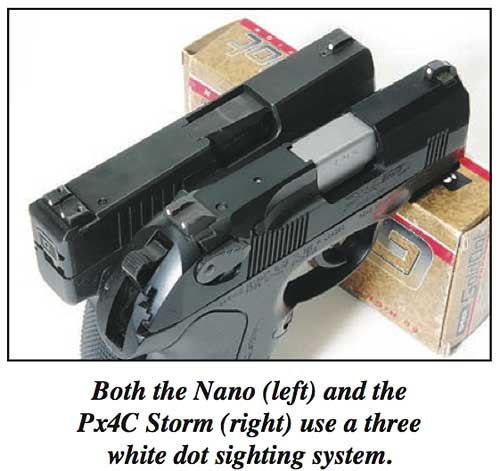
Cleaning
The Px4C Storm uses a modified Browning barrel slide and frame firing system. A captive recoil spring is beneath the barrel, whose chamber hood locks into the wide and ample ejection port.
Fieldstripping for cleaning or inspection is relatively easy. After clearing the pistol, lock the slide back and rotate the frame mounted and grooved takedown lever 90 degrees counterclockwise. The slide assembly is then removed forward from four short, frame mounted rails. The captive recoil spring on the guide rod requires only slight pressure to lift it free, allowing the barrel to be removed down and out to the rear of the slide. No further disassembly is necessary.
The dustcover has a short M1913 rail and the trigger guard is round, as is the smooth face of the pivoting trigger. The magazine catch is reversible and the checkered faced catch button is removable and can be replaced with two others, as there are three sizes – small, medium and large. (More on this later.) The supplied slide stop or catch is narrow grooved and an extended version is available. The inner curve at the top of the backstrap beneath the rear of the slide is rather pronounced, such that it allows for a high grip, yet does not allow any hammer or slide “bite.”
The front strap and the removable lower portion of the backstrap are crosshatched and the grip area is nicely contoured as well. And, as I noted earlier, the backstrap is changeable. It is held to the frame with a U-shaped retaining spring, with its arms extending up into the frame and the horizontal base of the “U” at the rear of the magazine well. Pry the spring out enough so that you can fully remove it from the frame. Position the selected replacement backstrap on the frame and press until it is fully seated in the frame.
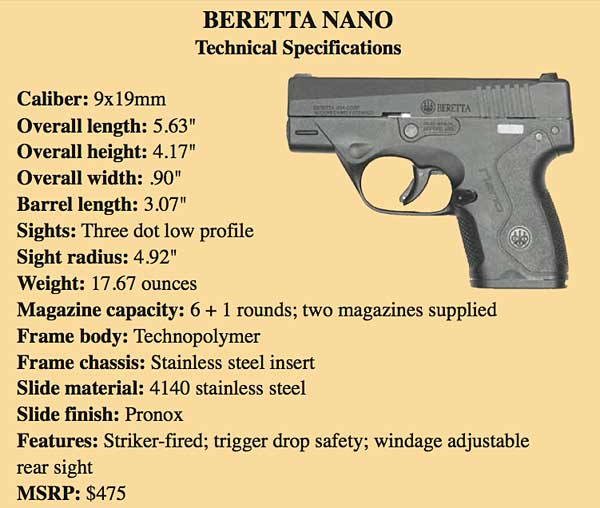
The Beretta Nano Pocket Pistol
The new Beretta Nano pocket pistol is all business. In short, it is a purposely “plain-Jane” pocket pistol. The Nano is small, with a long double-action type trigger pull of its striker firing system; it is thin, lightweight, has no protruding edges and has all of one external operating control – the magazine release. This release is user reversible, with instructions on doing this in the owner’s manual.
The magazine capacity is six rounds of 9x9mm cartridges or seven rounds if a round is chambered. Two six round metal magazines, with removable and extended base plates and five cartridge inspection holes on either side, are supplied.
The Nano frame, according to Beretta, is made of “Technopolymer,” a term of art for the fiberglass impregnated resin material used for this part. Other modern pocket pistols use formula variations of this material, including GLOCK, Smith & Wesson, Heckler & Koch and Walther, to name but a few. Obviously, this material is well established as being quite durable, as is the Beretta Pronox metal finish treatment of the slide and barrel, with a blued overfinish.
Features
The Nano’s front strap and backstrap have impressed checkering, while the rear area of the grip has a very lightly coarsened surface. Matching depressions forward on the frame past the trigger guard opening serve as “finger” placement indicators when handling the pistol. The frame slopes inward and down behind the trigger guard.
At the top right rear of the frame is the Striker Deactivation Button, while forward and directly above the trigger guard is the Disassembly Pin (more on these later).
Beretta compacts the operating controls, including the trigger, into one unit termed the “chassis”; this is the serialized “gun” portion of the pistol. While this unit is removable, a witness opening is in the top left side of the pistol, allowing the serial number to be seen without disassembly.
The stainless steel chassis is held in the frame by two cross pins. Detailed instructions and photos of how to remove the chassis from the frame, along with photos of the chassis itself, are in the owner’s manual.
The beauty of this chassis system (which has also been done by some other manufacturers) is that the frame can be replaced with another frame size, allowing users to have both a highly concealable handgun and a larger version if the owner’s wants or needs change. It also enables a more thorough cleaning if the owner wishes.
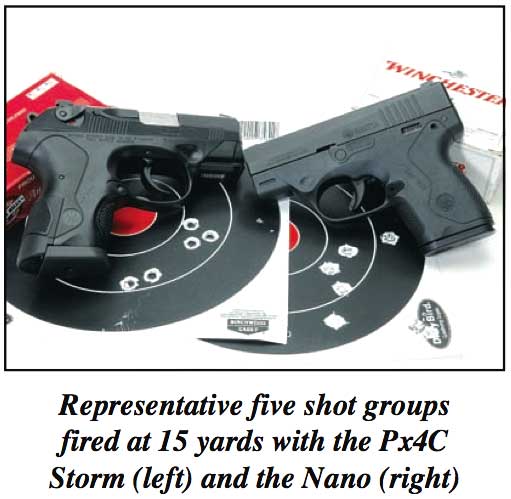
Specs
Nano specifications include the following: It is striker-fired, with no external hammer, and has three dot sights which are held in dovetail cuts and additionally secured with Allen screws. The rear sight is adjustable for horizontal sighting corrections. On this sample, I had to soak the screws for an hour with Liquid Wrench before I could loosen them. After doing so, and with a nonmarring punch and light hammer, I made the adjustment needed, as the gun shot a bit left for me at 12 yards. The magazine catch is at the lower left rear of the larger trigger guard and is reversible.
The Nano is 5.63 inches long, .90 inches wide and 4.17 inches high. It has a barrel length of 3.07 inches and weighs 17.67 ounces (unloaded). The trigger pull on this sample broke at 7.75 or eight pounds, depending on where I placed the trigger pull gauge arm on the face of the curved trigger. The trigger has a centered drop safety which protrudes from the trigger face. The safety is reflexively disengaged by depressing it with a complete pull of the trigger.
A large external extractor is at the center right rear of the ejection port, with six diagonal grasping grooves at the rear of the tapered slide. The forward face of the captive dual recoil spring is visible in the front face of the slide when the slide is forward.
Slide Catch
The Nano has no external slide catch. If you want to lock the slide back, you must use an empty magazine. To release the slide, a slight rearward tug is all that is needed. I’ve read elsewhere that this lack is a serious negative.
Disassembly is as follows. As the striker may well be cocked, it must be lowered to remove the slide, but the pistol does not have to be fired to release the striker. Pushing inward on the Striker Deactivation Button on the frame with a narrow pin or the tip of a ballpoint pen will do the trick.
Then, after releasing the striker, with a coin, cartridge case rim or other such tool, rotate the Disassembly Pin one quarter turn counterclockwise; the slide assembly can then be moved forward off the frame. It is not necessary to remove the Disassembly Pin from the frame. The captive dual recoil spring can be lifted out, as can the barrel. Reassembly is in the reverse order.
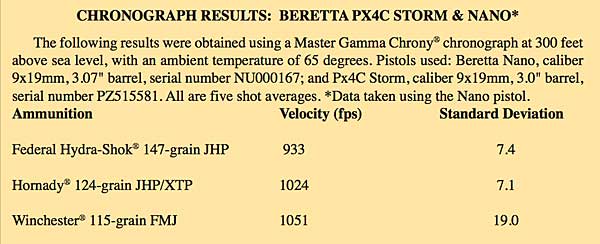
At the Range
I took both pistols to the range and began with the Nano which I found comfortable to shoot. It is stone reliable and as accurate (or not) as you are able to manipulate the faux double-action trigger which, for me, feels as good as, or better than, most modern double-action pocket revolvers.
The grip angle and the impressed checkering both helped keep the pistol seated in my hand when quickly firing multiple shots. I had two friends also shoot the Nano and none complained about its “two finger” grip. I did, however, find one shooter who fired a Nano at a trade show and said the gun literally was jumping out of her hand with every shot. As she’s an experienced, longtime action pistol competitor, the Nano grip design is simply not for her. Actually, her experience highlights the advantages of “trying before buying,” if at all possible.
At the Lower Providence Rod and Gun Club Range in Oaks, PA, my friends Irv Gill and Joe Mulligan helped get some rounds downrange against Birchwood Casey Shoot•N•C bull’s-eye and Warren IDPA training targets. Accuracy work was done while seated, using our shooting bench as a rest. After acclimating myself to the Nano’s long trigger pull, I managed to shoot a few five shot groups of less than three inches, with one group of five shot at 15 yards measuring two inches. Not surprisingly, the more I shot the gun, the better the results were.
Irv and Joe opted for freestyle ventilation of the Warren targets. Joe found the magazine’s extended base plate catching on part of his shooting hand when loading which went along with my finding, yet again, that my normal two-handed shooting grip doesn’t work with a little pocket auto, as my shooting finger eventually winds up digging into my support hand. Irv was a bit more noncommittal, as he favors revolvers for most any application, but he did say the gun handled well and was accurate.
In review, while in overall size, weight and magazine capacity, the Nano doesn’t stand above others of its kind – with the others being smaller, lighter or holding more ammo – it is small, light, accurate, reliable and holds enough 9x19mm ammo for self-defense and does so at a reasonable price.
Joe and Irv did similar shooting with the Px4C Storm and I shot some more groups. Not surprisingly, I found doing so much easier, what with a slightly larger and heavier pistol, along with a decent six pound, single-action and 11 pound double-action trigger pull weight.
The sights were easy to pick up and, as a bonus, I had good hits. Also, since I had repeatedly decocked the gun to fire both DA and SA, I found the decock lever easy to use, as was the slide stop.
I then installed the smaller backstrap and shot some basic exercises. Curiously, I liked the smaller grip. Did I have any negatives? Sure. I don’t care for the wide decock/safety levers, but they do seem to be less prone to accidental movement.
Comparing the Two
Comparison of the two is somewhat of an “apples and oranges” problem, as the two pistols are not – and are not claimed to be – equals. The only real negative, which applies to both, is that they are, and feel, top-heavy, with the weight being most noticeable toward their muzzles, as their slides outweigh their frames. Only being able to take a two finger grip doesn’t help either, as more “grip” is needed. The Px4C Storm gets the nod here, for when its magazine with the snap down finger rest is used, a three finger grip can then be had. Adding an extended base pad to the Nano would also do this, but then you wouldn’t have the ultraconcealability, one of the main reasons for buying the pistol in the first place.
The Px4C Storm is also the easier one to shoot well, as it offers a shorter and lighter single-action trigger pull, particularly when firing quickly. However, the price for this is not only the increased cost of including the DA/SA trigger, but also the larger frame which is required. Trite as the saying may be, there really is no “free lunch,” in guns or anywhere else. Also, for many, a manual safety is a must which the Nano lacks. Again, the Px4C Storm gets the nod. In contrast, it is one more movement – making it off safe – which must be done before the gun can fire…but will you remember to do so when blindsided by a threat?
To the overall good, both pistols are reasonably priced, with the Nano with a MSRP of just $475 and the Px4C Storm at $550, as noted earlier. Finally, both are backed by a company with a 500 year history of quality firearms manufacture which is reflected in these products. Experience and longevity do matter!
About the Author: Walt Rauch is a writer and lecturer in the firearms field. He is published regularly in many national and international publications and is the author of the self-defense book, REAL-WORLD SURVIVAL! What Has Worked For Me. Mr. Rauch has also authored, PRACTICALLY SPEAKING: AN ILLUSTRATED GUIDE to The Game, Guns and Gear of the International Defensive Pistol Association With Real-World Applications. To purchase a signed copy of Rauch’s books, phone (610)825-4245. Both books are also available at Amazon.com.